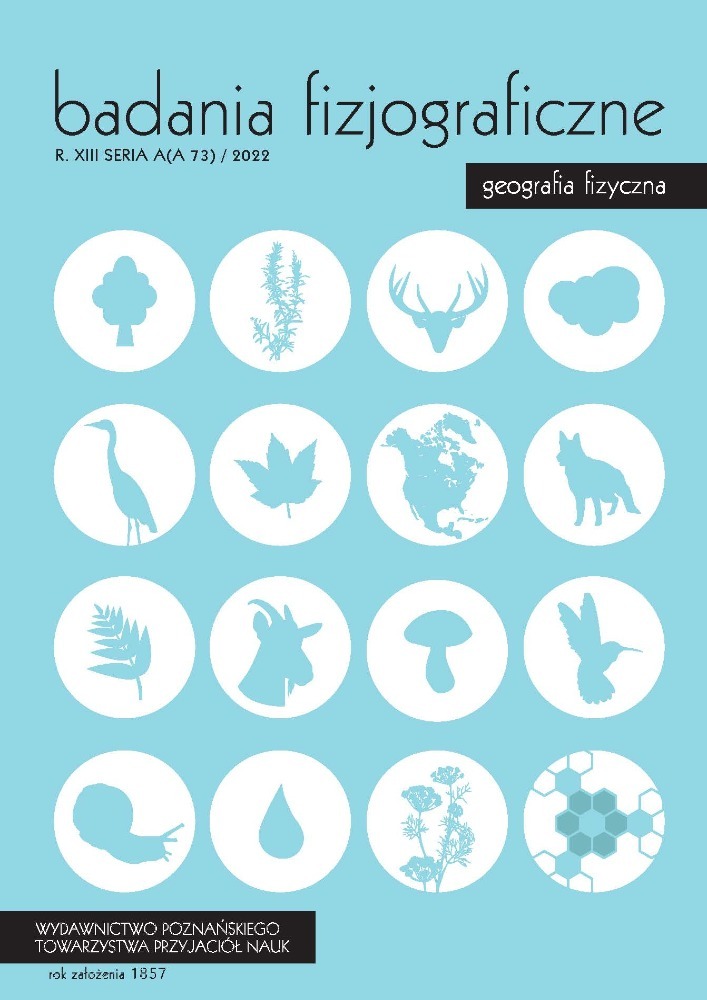Abstrakt
This study aims to identify the extent of mountain glacier influence on air temperature in the vertical profile, using the Engabreen glacier (Norway) as an example. An important aspect of the work is also an analysis of the variation in surface temperature and wind conditions in the valley of the Engabreen glacier. The analysis was carried out based on measurement data of vertical air temperature taken over the glacier cavity with sensors mounted to an unmanned aerial vehicle. The field survey was carried out on 25 July 2022 in the afternoon. The results of the measurements may indicate that the presence of the glacier reduces the air temperature gradient with altitude compared to the surrounding areas. Above the glacier, the air temperature in the vertical profile increases with height. Based on the profiles taken above the glacier, it was concluded that the surface of the glacier influences the air temperature above it up to an altitude of 37–53 m above ground level.
Bibliografia
Andreassen L.M., Elvehøy H., Jóhannesson T., Oerlemans J., Beldring S., Broeke van den M., 2006: Report No. 3 Modelling the climate sensitivity of Storbreen and Engabreen, Norway. Norwegian Water Resources and Energy Directorate.
Aubry-Wake C., Baraer M., McKenzie J.M., Mark B.G., Wigmore O., Hellström R.Å., Lautz L., Somers L., 2015: Measuring glacier surface temperatures with ground-based thermal infrared imaging. Geophys. Res. Lett., 42, 20, 8489–8497. DOI: https://doi.org/10.1002/2015GL065321
Avdan U., Jovanovska G., 2016: Algorithm for Automated Mapping of Land Surface Temperature Using LANDSAT 8 Satellite Data. J. Sens, 2016. DOI: https://doi.org/10.1155/2016/1480307
Bravo A., Quincey D.J., Ross A.N., Rivera A., Brock B., Miles E., Silva A., 2019: Air temperature characteristics, distribution, and impact on modeled ablation for the South Patagonia Icefield. J. Geophys. Res. Atmos., 124, 907–925. DOI: https://doi.org/10.1029/2018JD028857
Carturan L., Cazorzi F., De Blasi F., Dalla Fontana G., 2015: Air temperature variability over three glaciers in the Ortles–Cevedale (Italian Alps): effects of glacier fragmentation, comparison of calculation methods, and impacts on mass balance modeling. TC, 9, 1129–1146. DOI: https://doi.org/10.5194/tc-9-1129-2015
Cohen D., Iverson N.R., Hooyer T.S., Fischer U.H., Jackson M., Moore P.L., 2005: Debris-bed friction of hard-bedded glaciers. J. Geophys. Res., 110, F02007. DOI: https://doi.org/10.1029/2004JF000228
Ebrahimi S., Marshall S.J., 2016: Surface energy balance sensitivity to meteorological variability on Haig Glacier, Canadian Rocky Mountains. TC, 10, 6, 2799–2819. DOI: https://doi.org/10.5194/tc-10-2799-2016
Minder J.R., Mote P.W., Lundquist J.D., 2010: Surface temperature lapse rates over complex terrain: Lessons from the Cascade Mountains. J. Geophys. Res., 115, D14122. DOI: https://doi.org/10.1029/2009JD013493
Oerlemans J., Grisogono B., 2002: Glacier winds and parameterisation of the related surface heat fluxes. Tellus A: Dyn. Meteorol. Oceanogr., 54: 5, 440–452. DOI: https://doi.org/10.1034/j.1600-0870.2002.201398.x
Oerlemans J., Björnsson H., Kuhn M., Obleitner F., Palsson F., Smeets C.J.P.P., Vugts H.F., De Wolde J., 1999: Glacio-Meteorological Investigations On Vatnajökull, Iceland, Summer 1996: An Overview. Bound.-Layer Meteorol., 92, 3–24. DOI: https://doi.org/10.1023/A:1001856114941
Petersen L., Pellicciotti F., Juszak I., Carenzo M., Brock B.W., 2013: Suitability of a constant air temperature lapse rate over an alpine glacier: Testing the Greuell and Böhm model as an alternative. Ann. Glaciol., 54, 63, 120–130. DOI: https://doi.org/10.3189/2013AoG63A477
Shaw T., Brock B., Ayala A., Rutter N., Pellicciotti F., 2017: Centreline and cross-glacier air temperature variability on an Alpine glacier: assessing temperature distribution methods and their influence on melt model calculations. J. Glaciol., 63, 242. DOI: https://doi.org/10.1017/jog.2017.65
Shea J.M., Moore R.D., 2010: Prediction of spatially distributed regional-scale fields of air temperature and vapor pressure over mountain glaciers. J. Geophys. Res., 115, D23107. DOI: https://doi.org/10.1029/2010JD014351
Solgaard A.M., Messerli A., Schellenberger T., Hvidberg C.S., Grinsted A., Jackson M., Zwinger T., Karlsson N.B., Dahl-Jensen D., 2018: Basal conditions at Engabreen, Norway, inferred from surface measurements and inverse modelling. J. Glaciol., 64, 246, 555–567. DOI: https://doi.org/10.1017/jog.2018.45
Trepińska J., 2002: Górskie klimaty. IGiGP UJ, Kraków.
Zawiślak J., 2010: Słownik tematyczny terminów, wyrażeń i zwrotów stosowanych w prognozach meteorologicznych. IMGW, Warszawa.
EarthExploler, https://earthexplorer.usgs.gov [dostęp: 16.10.2022].
Elevationapi.com, https://elevationapi.com/playground_3dbbox.
Glacier.nve.no, http://glacier.nve.no/Glacier/viewer/CI/en/nve/ClimateIndicatorInfo/1094?name=Engabreen [dostęp: 2.11.2022].
Nve.no, https://www.nve.no/Hydrology/Glaciers/Svartisen-subglacial-observatory/ [dostęp:2.11.2022].
Rawinsonde.com, http://rawinsonde.com/ERA5_Europe/ [dostęp: 10.11.2022].
Statkart.no, https://openwms.statkart.no/skwms1/wms.topo4.
Wetter3.de, https://www.wetter3.de/archiv_gfs_dt.html [dostęp: 26.10.2022].
Licencja
Prawa autorskie (c) 2022 Wiktoria Dyszy, Zofia Grajek

Utwór dostępny jest na licencji Creative Commons Uznanie autorstwa – Użycie niekomercyjne – Bez utworów zależnych 4.0 Międzynarodowe.
PTPN ma prawa autorskie do tytułu czasopisma
 https://creativecommons.org/licenses/by-nc-nd/4.0/
https://creativecommons.org/licenses/by-nc-nd/4.0/

